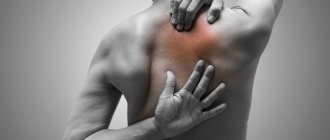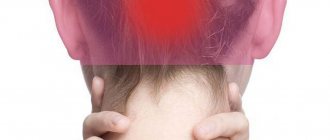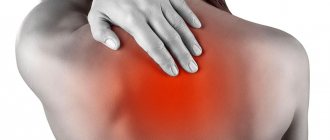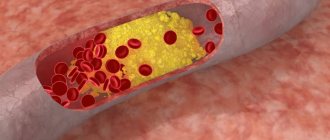12 April 2021
71224
0
2.8 out of 5
Although pain between the shoulder blades is not very common, for those who experience it, this is small consolation. At the same time, discomfort in the area between the shoulder blades can be a sign of a fairly large number of different diseases, some of which can lead to very serious complications and significantly reduce a person’s quality of life. Moreover, if pain in the neck or lower back can be a consequence of banal muscle fatigue after hard physical work, then pain between the shoulder blades due to low mobility of the thoracic spine cannot be of such a harmless nature. Therefore, their appearance should always be regarded as an alarming symptom and immediately contact a vertebrologist, neurologist or spinal surgeon.
Pain between the shoulder blades
One of the most common complaints when visiting a doctor is back pain.
However, it is the pain in the interscapular region that most people often ignore, since it is rarely very strong, due to the lack of mobility of the thoracic spine. The thoracic spine does not have such an increased load as the cervical and lumbar spine. The shoulder blades are flat bones that fit tightly to the ribs of the posterior chest wall, performing a protective function and taking part in the formation of the girdle of the upper limbs. In the space behind the scapula along the intercostal spaces there are vessels and intercostal nerves, strengthened by muscles and ligaments. Most of the muscular frame of the back and the girdle of the upper limbs is attached to the shoulder blades.
You need to know that back pain between the shoulder blades is not a disease, but a symptom of a fairly wide range of pathologies, such as osteochondrosis and other diseases of the spine, diseases of the ligamentous-muscular system, the result of muscle spasm and pinched nerve roots in this area, various diseases of the internal organs: respiratory system, heart, stomach, mediastinal organs.
Therefore, before self-medicating using various ointments for back pain, it is necessary to find out what was the real cause of the pain syndrome. Medicines with analgesic properties are not, in fact, treatment and have only a temporary and rather deceptive effect. Accurate and quick diagnosis will help to avoid the development of severe chronic processes and complications.
Treatment of pain in the shoulder blades
For each of our patients, depending on their condition, treatment is selected individually by the doctor. At the Alan Clinic Center for Neurology and Orthopedics, there is a whole range of methods for this, ranging from time-tested massage and physical therapy to modern techniques.
Of course, we can alleviate your condition, no matter what stage your illness is, but the sooner you do this, the more productive the treatment and speedy recovery will be.
We have at our disposal the following methods:
- Manual therapy;
- Osteopathy - treatment by the hands of a doctor, a gentle effect on the musculoskeletal system, nervous and vascular systems, internal organs;
- Yumeiho therapy;
- Medical massage;
- Acupuncture - exposure to biologically active points with microneedles;
- Laser reflexology is a painless effect on reflexogenic zones and points;
- Tsubotherapy is a gentle effect on the body’s reflex points;
- Pharmacopuncture - the introduction of medicinal drugs of natural origin to the source of the problem;
- Plasma therapy is the introduction of the patient’s own purified blood into the site of the disease;
- Isometric kinesiotherapy - individual gymnastic techniques/exercises, according to indications, with elements of joint massage;
- Kinesiotherapy using the Exart installation;
- Kinesio taping;
- Ozone therapy - treatment with active oxygen;
- Physiotherapy;
- Physiotherapy with enzyme preparations;
- Therapeutic droppers;
- Hirudotherapy - treatment with leeches;
- Botulinum therapy - treatment with botulinum toxin;
- Intra-articular injection of synovial fluid endoprostheses;
- Intra-articular blockades.
The main causes of back pain between the shoulder blades:
- imbalance of physical activity: when the muscles and ligaments of the back are weakened as a result of their hypotrophy, or, conversely, when there is excessive physical activity with loads that are too heavy for the spine - lifting weights, sharp turns of the body, jumping;
- various spinal injuries;
- osteochondrosis;
- curvature of the spine - kyphosis, kyphoscoliosis, scoliosis;
- spondyloarthrosis;
- pathologies in the thoracic spine, such as protrusions and herniated intervertebral discs;
- humeroscapular periarthritis and periarthrosis;
- intercostal neuralgia;
- myositis;
- IHD, angina pectoris, pre-infarction conditions, myocardial infarction;
- shingles;
- mediastinal pathologies;
- diseases of the respiratory system - pneumonia, pleurisy, pulmonary abscess, bronchiectasis, malignant tumors;
- infectious diseases - tuberculosis, polio;
- pathological processes of the esophagus, stomach, duodenum;
- liver and gallbladder diseases - hepatitis and cholecystitis;
- kidney pathology;
- occupational disease of the spine as a result of harmful working conditions;
- systemic diseases, ankylosing spondylitis;
- tumor metastases in the spine.
Possible nature of pain
It must be taken into account that this criterion does not provide a 100% guarantee of accurate diagnosis, since the pain sensations and pain threshold in people with the same disease will not be the same.
Examples of diseases based on the nature of interscapular pain:
Sharp pain is typical as a response to irritation, inflammation or pinching of the spinal nerve roots. Pain is characteristic of radiculitis, which in turn can be a consequence of pathologies such as osteochondrosis or scoliosis. When swelling and inflammation occur in the area of the pinched root, certain back muscles reflexively tense. Muscle spasm further compresses the root.
With biliary colic, sharp pain also appears in the interscapular region, but in addition – pain in the right hypochondrium. The pain occurs after eating spicy, fatty foods, appearing after a few hours. There is a deterioration in general health with the appearance of nausea and vomiting.
Severe pain is typical:
- with protrusions of intervertebral discs;
- with intercostal neuralgia, the painful sensations have a paroxysmal, encircling character, the pain is localized, as a rule, on one side, and intensifies when tilting to this side and pressing on the affected area;
- with pancreatitis, in addition, the general condition is disturbed, bloating and diarrhea appear;
- With myocardial infarction, there is a significant deterioration in well-being, with arrhythmia, decreased blood pressure, and loss of consciousness.
Burning pain is observed in two conditions - coronary heart disease, angina pectoris and osteochondrosis. Cardiac pathology is characterized by burning, squeezing, pressing pain, which disappears a few minutes after taking nitroglycerin, subsides at rest and does not depend on movements. Pain in the back between the shoulder blades, when the nerve roots are pinched, does not respond to nitroglycerin, and after taking painkillers it calms down, depending on movements and a certain position.
Acute pain may occur:
- with cholecystitis, also appearing with pain in the right hypochondrium, when eating fatty, spicy, fried foods;
- with a stomach ulcer - unbearable pain, radiating to the supraclavicular region or under the left shoulder blade, caused by irritation of the endings of the phrenic nerve, accompanied by abdominal pain. May be accompanied by nausea and vomiting;
- with exacerbation of osteochondrosis, acute pain occurs when moving or lifting heavy objects.
Aching pain is associated with diseases of the spine and bones, such as:
- herniated intervertebral discs.
- kyphoscoliosis - with curvature of the spine, pain between the shoulder blades occurs at points of change in the spinal column as a result of compression of the intervertebral nerves.
- scapular-costal syndrome, which occurs due to inflammation of the synovial bursae of the scapula or as a result of damage to the muscles attached to it, as well as injuries and fractures after prolonged immobilization of the arm. Complaints of aching pain between the shoulder blades, closer to their upper inner corner, accompanied by radiating pain in the shoulder or lateral surface of the chest, complaints of a feeling of heaviness.
- fibromyalgia - damage to extra-articular soft tissues, characterized by diffuse musculoskeletal pain between the shoulder blades, combined with a feeling of morning stiffness;
- spondyloarthrosis - damage to the joints of the spine. In patients with cervical spondyloarthrosis (cervicoarthrosis), pain occurs in the neck, radiating to the shoulder girdle, to the area of the scapula (dorsarthrosis), and the interscapular region. With thoracic spondyloarthrosis, pain rarely reaches a significant degree of severity.
- The same manifestations may occur in some cases with ischemic heart disease and peptic ulcer disease.
Nagging pain in the back between the shoulder blades is characterized by pathologies of the bone and muscle-ligamentous structure:
- osteochondrosis of the cervical spine;
- osteochondrosis of the thoracic spine;
- scapular-costal syndrome;
- myofascial syndrome;
Dull pain occurs with damage to the tendons and ligaments and muscle pathology in almost 90% of cases. The remaining 10% is divided between osteochondrosis and diseases of internal organs - angina pectoris, pneumonia, cholelithiasis, cholecystitis. Pain in the back between the shoulder blades, which does not radiate to other parts of the body, increases with physical activity that involves sore muscles, with pain when palpated, is characteristic of spinal pathology, osteochondrosis.
Stitching pain in the back between the shoulder blades can be a symptom of a disease such as pleurisy, accompanied by cough and weakness. Also, such pain is typical when perforation of an ulcer begins, with the presence of symptoms such as nausea, bloating and abdominal pain, heartburn. Stitching pain in the interscapular area can be:
- with vegetative-vascular dystonia,
- biliary colic,
- pyelonephritis.
Get a free consultation by phone
What to do if there is pain under the shoulder blade?
If you are unable to go to the clinic immediately, you must:
- remove tight clothing;
- lie down in the most comfortable position;
- rid the room of drafts, cover yourself with a blanket;
- take painkillers;
- measure pulse, temperature and pressure;
- refuse to eat fatty and smoked foods;
- Take only warm, not hot or cold baths.
If there is a sudden change in blood pressure, high temperature or irregular heart rhythm, call an ambulance. Otherwise, try to see a doctor as soon as you feel better.
What signs may accompany pain?
The symptoms accompanying back pain between the shoulder blades will help in diagnosing the real cause of the pain.
The back between the shoulder blades “sears, burns” - this combination of symptoms can be caused by: osteochondrosis of the cervical or thoracic spine; an attack of renal colic; biliary colic; reflux esophagitis.
A feeling of numbness in the back combined with pain between the shoulder blades can be caused by: osteochondrosis; humeroscapular periarthritis; kyphosis and kyphoscoliosis; spondyloarthrosis; coronary heart disease; biliary dyskinesia, peptic ulcer; pleurisy; pneumonia.
Itching of the back and pain in the interscapular area is a rather rare combination of symptoms. The cause of back pain can be biliary colic, as well as herpes zoster.
The back between the shoulder blades feels cold and hurts - a combination of symptoms can be caused by two diseases: pinched spinal nerve root and exacerbation of a disease such as chronic pyelonephritis.
An increase in temperature that accompanies pain between the shoulder blades is typical for pneumonia, pulmonary or bone tuberculosis, hepatitis, cholecystitis, pancreatitis and pyelonephritis.
Cough and back pain between the shoulder blades are symptoms characteristic of diseases of the bronchopulmonary system, such as pneumonia with pleurisy, tracheitis, tuberculosis, lung tumors.
Breathing heavily and your back hurts between your shoulder blades are definitely symptoms of lung damage, a manifestation of pneumonia and pleurisy.
A lump in the throat, combined with back pain between the shoulder blades, indicates that there are pathologies of the esophagus:
- inflammatory diseases,
- tumors
- cirrhosis of the liver with varicose veins of the esophagus.
Belching and back pain between the shoulder blades - this combination of symptoms indicates that the upper gastrointestinal tract is affected. Characteristic of peptic ulcer and cholelithiasis, gastroesophageal reflux.
Nausea and pain between the shoulder blades occur with peptic ulcers, with myocardial infarction, with subdiaphragmatic abscess, as well as with kidney diseases and liver disease.
The symptom of shortness of breath indicates that the condition is life-threatening and the patient urgently needs medical help. The combination of signs of shortness of breath and back pain in the area of the shoulder blades is typical for pneumonia, pericarditis, and pneumothorax. Pain accompanied by shortness of breath, cough and hemoptysis, weakness and fever indicates that an urgent call to the doctor is necessary, rather than thinking about the origin of the pain.
Treatment
Help before diagnosis
Without establishing the cause of pain in the right shoulder blade, the doctor cannot give specific recommendations. If the patient’s condition is satisfactory, the examination is carried out on an outpatient basis, and standard analgesics from the group of non-steroidal anti-inflammatory drugs or antispasmodics are prescribed to relieve pain. If, in addition to pain, the state of health sharply deteriorates, the person is immediately hospitalized.
Conservative therapy
After determining the origin of the pain under the right shoulder blade, complex drug treatment is carried out. Most diseases are subject to outpatient therapy, but during a period of severe exacerbation of a chronic process, it is advisable to undergo a course in a hospital. Drugs are selected based on the location of the disorders:
- When the hepatobiliary system is damaged,
choleretic agents are used - choleretics, cholekinetics or their combinations, hepatoprotectors, antibacterial drugs. To correct hypermotor dyskinesia of the gallbladder, antispasmodics are prescribed. - In case of vertebral pathology,
therapeutic blockades or electrophoresis with analgesics are performed to relieve severe pain. In order to eliminate the neurological complications of osteochondrosis, B vitamins and neurometabolic agents are used. - For bronchopulmonary diseases
, massive antibiotic therapy is most often recommended, and expectorant, anti-inflammatory, and antihistamine medications are indicated to eliminate associated symptoms. When infected with Koch's bacillus, long-term anti-tuberculosis treatment is required.
Pharmaceutical treatment of the causes of pain under the scapula on the right is complemented by non-drug methods. This is especially important for diseases of the spinal column, the correction of which requires wearing supportive corsets, traction therapy, kinesiological taping and exercise therapy. According to strict indications, massage and manual therapy are performed. For functional changes in the gallbladder, acupuncture methods, ozokerite applications, and inductothermy are effective.
Surgery
Surgical methods are appropriate for serious injuries of the scapula and bones of the shoulder girdle, when open reposition of bone fragments and osteosynthesis are indicated. In orthopedic practice, surgical interventions are resorted to when there is compression of the spinal cord, accompanied by unbearable pain. Among minimally invasive methods, puncture vaporization of the disc and microdiscectomy are popular.
In case of hepatic colic, biliary peritonitis, perforation or bleeding from a duodenal ulcer, emergency assistance from abdominal surgeons is required. In case of pulmonary infarction, pulmonary hemorrhage and tension pneumothorax, the participation of specialists in the field of thoracic surgery is necessary. Treatment of skin tumors is carried out by oncodermatologists who combine surgical, chemotherapy and radiation treatment.
What to do for back pain between the shoulder blades?
Emergency treatment of back pain between the shoulder blades is required if it is severe. Excruciating sensations, when the patient is unable to endure them, are rarely caused by interscapular pain. Such pain, caused by irritation of the nerve roots, is characteristic of the lumbar region.
Getting rid of pain caused by muscle spasms on your own is not very difficult. If you feel a feeling of heaviness or tension between your shoulder blades that appears during work, it will be enough to change your position and perform physical exercises. For example, bringing your shoulder blades together and spreading them apart, using circular movements of your shoulders - this exercise will be enough to improve your condition.
Mandatory attributes of the treatment process for any back pain include temporary pain relief using anti-inflammatory non-steroidal drugs for these purposes: ibuprofen, movalis, diclofenac, nimesil. You can use both injections and tablets and preparations in ointment form, as well as combining them to enhance the analgesic effect.
The case when the administration of analgesics reduces the pain, or it goes away completely, indicates that the disease that caused it is relatively compensated. But if the pain persists, it is imperative to undergo the necessary examinations.
The presence of prolonged pain in the interscapular area is a reason to seek help from a doctor!
There are many causes of interscapular back pain, and this can seriously complicate diagnosis.
Most often, the starting point for diagnosis is radiography of the thoracic spine and lungs in projections (direct and lateral). Depending on the data received, the doctor creates a further diagnostic program.
If your back hurts with obvious signs of lung disease, the doctor will definitely prescribe a clinical blood test in order to exclude or confirm inflammatory changes.
If your back hurts and there is a suspicion of an intervertebral hernia or metastases, a CT or MRI of the spine and chest is prescribed.
To make an accurate diagnosis, the doctor often conducts studies that, at first glance, are in no way related to each other. After X-rays and MRIs, the patient may be sent for an electrocardiogram and examination by a cardiologist to rule out heart disease.
When contacting a doctor, it is very important to describe accurate data about the nature of the pain, all accompanying symptoms that accompany the pain from the moment of its onset, as well as factors that provoke increased pain, since the doctor needs help to determine the direction of examinations. Often, unrecognized diseases become the cause of diagnostic errors and inadequate treatment.
Most often, the cause of back pain in this case is muscle spasm in the interscapular area, but doctors must exclude all possible diagnoses, especially in cases where the prescribed treatment does not bring a noticeable result.
What diseases can cause pain
The spine between the shoulder blades and the neck hurt due to a large number of diseases. It is important to understand the causes of pain in order to begin proper treatment.
Cervicothoracalgia
This pathology characterizes a condition in which a person complains of pain in the neck and thoracic spine. The most common cause of cervitothoracalgia is osteochondrosis, leading to a narrowing of the canal in which the spinal cord is located, to the formation of osteophytes, as well as irritation of the nerve roots. Pain in the neck and chest in this condition can be different - the pain can be nagging, aching, strong, sharp and even shooting. Exacerbation of pain is easy to provoke - often a person cannot even turn his head normally.
Vertebrogenic cervicalgia
In this state, a person, in addition to complaining that the right shoulder blade and neck hurts, also notes a number of other extremely unpleasant symptoms. These may include:
- visual dysfunction;
- dizziness;
- autonomic dysfunction;
- limited neck mobility, crunching, neck muscle tension.
The condition can be provoked by any disease of the musculoskeletal system affecting the cervical spine - arthritis, spondylosis, osteoporosis and many others.
Thoracalgia
It is a condition in which a person has severe pain in the thoracic region. Often the cause is intercostal neuralgia, when nerve tissue is pinched, and a person experiences severe pain that radiates to the arms, head, etc. An exacerbation of the condition can occur at any time due to the adverse effects of cold, physical exertion, poor body position, etc.
Treatment of back pain between the shoulder blades
To eliminate pain in the interscapular area, complex treatment is used, including drug therapy, physiotherapeutic methods and physical therapy. The course of treatment is selected individually, the most effective combination of methods and the scheme for their use are selected.
If interscapular back pain is caused by osteochondrosis and is vertebrogenic and neurogenic in nature, then physiotherapeutic treatment is an alternative to non-steroidal painkillers.
Physiotherapy methods:
- electrophoresis,
- electroanalgesia,
- magnetotherapy,
- ultrasound therapy,
- barolasertherapy,
- autogravitational traction of the spine,
- paraffin-ozokerite applications
reduce inflammation and pain and at the same time treat the underlying disease that caused back pain between the shoulder blades.
Manual therapy and massage are prescribed only for pain caused by diseases of the spine and nerve roots.
Physical therapy is prescribed only after pain has reduced.
It is recommended that during treatment for back pain, as well as for several days after the end of the treatment process, following a regimen that is as gentle as possible for the spine, excluding physical activity.
In the event that back pain between the shoulder blades occurs for the first time and is very severe, if the pain spreads to the chest, accompanied by any additional symptoms, nothing other than short-term pain relief should be used and you should immediately seek medical help.
Prevention measures
The only and most reliable method of prevention in this case will be an active lifestyle with the absence of bad habits and excess stress. It is necessary to maintain proper physical shape, do gymnastics, learn to move correctly, always monitor your posture, there must be comfortable and correct conditions for work, rest and sleep. If you work for a long time in an uncomfortable position, you need to do warm-up exercises and self-massage more often. Swimming in the pool will perfectly relieve muscle tension.
“Medical Center Yes!” in St. Petersburg, providing a wide range of diagnostic and therapeutic services, specializing in the treatment of neurological and therapeutic diseases. The healing process in our center is carried out taking into account the dynamics of the patient’s condition at different stages of treatment, under the supervision of specialists. Our doctors have developed complex therapy programs aimed at quickly eliminating pain syndromes and the causes of pain. Qualified specialists at our center will help the patient cope with back pain and return to normal life.
Find out about promotions by phone: +7 (812) 323-15-03
All rights reserved by copyright law. No part of the contents of the site may be used, reproduced, transmitted by any electronic, copying or other means without the prior written permission of the copyright owner.
Features of treatment
To treat neck pain that radiates to the shoulder blades, you need to contact a qualified specialist. You can only eliminate pain if you eliminate the cause of its occurrence. Suppressing pain with analgesics is not the best solution, since the disease will continue to progress, leading to complications and deterioration of the general condition. Treatment is usually complex. If the problem lies in pathologies of the musculoskeletal system, for treatment the doctor prescribes:
- medicines;
- exercises;
- massage.
In addition to everything, it is worth using traditional medicine, but not forgetting about the main course of treatment and preliminary consultation with a neurologist .
Who should I contact if I have pain under the shoulder blade?
If there is pain under the shoulder blade when inhaling, the help of a therapist is necessary. If, in addition to pain, there are other symptoms, it is better to contact a specialist immediately:
- in case of pressure surges or changes in pulse, see a cardiologist;
- for nausea and problems with stool – see a gastroenterologist;
- If there is impaired mobility, clicking or crunching when turning the body, contact an orthopedist or neurologist.
In addition to a medical examination, various diagnostic procedures are necessary to make a correct diagnosis:
- X-ray;
- MRI;
- CT;
- ECG;
- EGDS;
- lab tests.
A comprehensive diagnosis will help the doctor determine the true cause of the ailment, for example, identify osteochondrosis, which is “masked” as gastritis.











